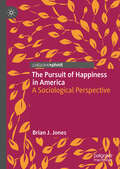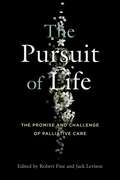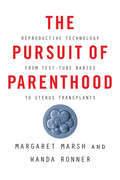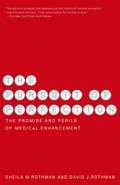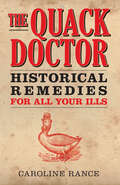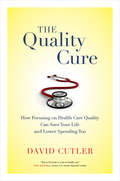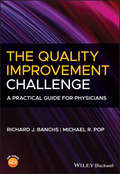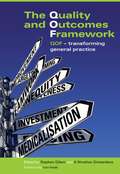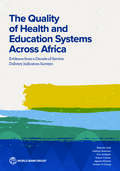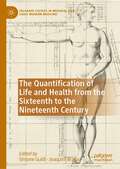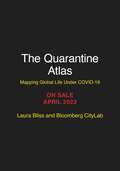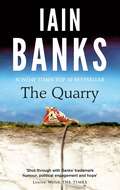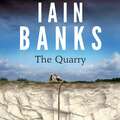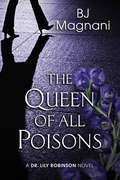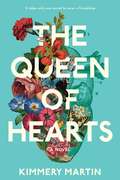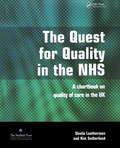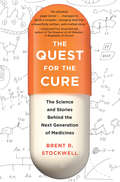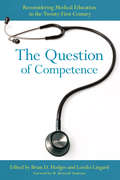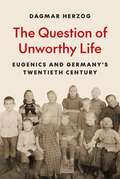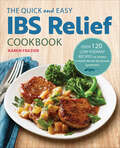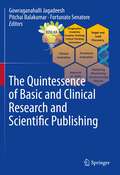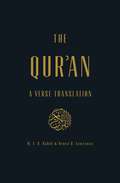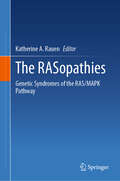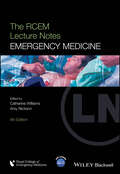- Table View
- List View
The Pursuit of Happiness in America: A Sociological Perspective
by Brian J. JonesEverybody wants to know what makes people happy. Artistic takes on the topic in literature, popular songs and cinema are widespread, but not terribly helpful. Psychological accounts are mostly about how to avoid unhappiness. So who actually is happy, and why? This book offers real answers from the real world of American society. Their source is the General Social Survey, a scientific poll of Americans offering some five decades of state-of-the-art data. An additional enhancement is a set of qualitative interviews commissioned by the author adding depth to the extraordinary breadth of the GSS. The approach of the book is distinctly sociological. Are married Americans happier than unmarried Americans? Does social class matter? How about college? The answers lie within this wide and deep dive into happiness in America.
The Pursuit of Life: The Promise and Challenge of Palliative Care
by Robert Fine, Jack Levison and Kelsey SpinnatoThis volume examines crucial concerns in palliative care, including the proper balance between comfort and cure for the patient, the integration of spiritual well-being, and the challenges of providing care in the absence of basic medical services and supplies.In the first section, palliative-care pioneers Constance Dahlin, Eduardo Bruera, Neil MacDonald, and Declan Walsh recount the early history of the discipline. Part 2 discusses the role of poetry, prose, plays, and other aspects of the humanities in the practice of palliative care. Part 3 explores essential current issues in the field, including autonomy, the use of opioids, and the impact of artificial intelligence on the evolution of palliative care. The final section focuses on the spiritual dimensions of pain and suffering.Rich with anecdotes and personal stories and featuring contributions from pioneers and current practitioners, The Pursuit of Life is an essential assessment of the past, present, and future of palliative care. In addition to the editors, the contributors include W. Andrew Achenbaum, Stacy L. Auld, Elena Pagani Bagliacca, Costantino Benedetti, Courtenay Bruce, Eduardo Bruera, Joseph Calandrino, Jim Cleary, Constance Dahlin, Andrea Ferrari, Mauro Ferrari, Joseph J. Fins, Bettie Jo Tennon Hightower, Kathryn B. Kirkland, Robin W. Lovin, Neil MacDonald, Charles Millikan, Dominique J. Monlezun, Tullio Proserpio, Giovanna Sironi, Daniel P. Sulmasy, and Declan Walsh.
The Pursuit of Parenthood: Reproductive Technology from Test-Tube Babies to Uterus Transplants
by Margaret Marsh Wanda RonnerA wide-ranging history of assisted reproductive technologies and their ethical implications.Finalist of the PROSE Award for Best Book in History of Science, Medicine and Technology by the Association of American PublishersSince the 1978 birth of the first IVF baby, Louise Brown, in England, more than eight million children have been born with the help of assisted reproductive technologies. From the start, they have stirred controversy and raised profound questions: Should there be limits to the lengths to which people can go to make their idea of family a reality? Who should pay for treatment? How can we ensure the ethical use of these technologies? And what can be done to address the racial and economic disparities in access to care that enable some to have children while others go without?In The Pursuit of Parenthood, historian Margaret Marsh and gynecologist Wanda Ronner seek to answer these challenging questions. Bringing their unique expertise in gender history and women's health to the subject, Marsh and Ronner examine the unprecedented means—liberating for some and deeply unsettling for others—by which families can now be created. Beginning with the early efforts to create embryos outside a woman's body and ending with such new developments as mitochondrial replacement techniques and uterus transplants, the authors assess the impact of contemporary reproductive technology in the United States. In this volume, we meet the scientists and physicians who have developed these technologies and the women and men who have used them. Along the way, the book dispels a number of fertility myths, offers policy recommendations that are intended to bring clarity and judgment to this complicated medical history, and reveals why the United States is still known as the "Wild West" of reproductive medicine.
The Pursuit of Perfection: The Promise and Perils of Medical Enhancement
by David Rothman Sheila RothmanWhat does it mean to live in a time when medical science can not only cure the human body but also reshape it? How should we as individuals and as a society respond to new drugs and genetic technologies? Sheila and David Rothman address these questions with a singular blend of history and analysis, taking us behind the scenes to explain how scientific research, medical practice, drug company policies, and a quest for peak performance combine to exaggerate potential benefits and minimize risks. They present a fascinating and factual story from the rise of estrogen and testosterone use in the 1920s and 1930s to the frenzy around liposuction and growth hormone to the latest research into the genetics of aging. The Rothmans reveal what happens when physicians view patients' unhappiness and dissatisfaction with their bodies--short stature, thunder thighs, aging--as though they were diseases to be treated. The Pursuit of Perfection takes us from the early days of endocrinology (the belief that you are your hormones) to today's frontier of genetic enhancements (the idea that you are your genes). It lays bare the always complicated and sometimes compromised positions of science, medicine, and commerce. This is the book to read before signing on for the latest medical fix.From the Hardcover edition.
The Putting Patients First Field Guide: Global Lessons in Designing and Implementing Patient-Centered Care (Jossey-Bass Public Health #216)
by Planetree Foundation"This book answers 'why not' and 'how to' for health care accreditation bodies, quality experts, and frontline professionals, moving the reader from timely information, to inspiration, and through patient-centered action with practical tools and potent case studies." —Paul vanOstenberg, DDS, MS, vice president, Accreditation and Standards, Joint Commission International "This superb guide from Planetree illustrates that providing high-quality, high-value, patient-centered health care is not a theoretical ideal. The case studies make clear that these goals are attainable; they are being achieved by leading health care organizations worldwide, and there is a clear road map for getting there—right here in this book." —Susan Dentzer, senior policy adviser to the Robert Wood Johnson Foundation "At IHI, we follow the principle, 'all teach, all learn'—the idea that everyone, everywhere has something to teach, and something to learn. This remarkable and indispensable guide is as pure an example of this principle as I've come across." —Maureen Bisognano, president and chief executive officer, Institute for Healthcare Improvement "The International Society for Quality in Health Care's mission is to inspire, promote, and support continuous improvement in the quality and safety of health care worldwide. It is in this spirit that we welcome this new book on patient-centered care. As in their previous work, the authors demonstrate just how critical it is to develop an organizational culture that puts patients first." —Peter Carter, chief executive officer, International Society for Quality in Health Care
The Quack Doctor: Historical Remedies For All Your Ills
by Caroline RanceFrom the harangues of charlatans to the sophisticated advertising of the Victorian era, quackery sports a colourful history. Featuring entertaining advertisements from the nineteenth and early twentieth centuries, this book investigates the inventive ways in which quack remedies were promoted – and suggests that the people who bought them should not be written off as gullible after all. There’s the Methodist minister and his museum of intestinal worms, the obesity cure that turned fat into sweat, and the device that brought the fresh air of Italy into British homes. The story of quack advertising is bawdy, gruesome, funny and sometimes moving – and in this book it takes to the stage to promote itself as a fascinating part of the history of medicine.
The Quality Cure
by David CutlerIn the United States, the soaring cost of health care has become an economic drag and a political flashpoint. Moreover, although the country's medical spending is higher than that of any other nation, health outcomes are no better than elsewhere, and in some cases are even worse. In The Quality Cure, renowned health care economist and former Obama advisor David Cutler offers an accessible and incisive account of the issues and their causes, as well as a road map for the future of health care reform--one that shows how information technology, realigned payment systems, and value-focused organizations together have the power to resolve this seemingly intractable problem and transform the US health care system into one that is affordable, efficient, and effective.
The Quality Improvement Challenge: A Practical Guide for Physicians
by Richard J. Banchs Michael R. PopEfforts to improve the quality of healthcare have failed to achieve a meaningful and sustainable improvement. Patients continue to experience fragmented, inconvenient, and unsafe care while providers are increasingly becoming overburdened with administrative tasks. The need for change is clear. Healthcare professionals need to take on new leadership roles in quality improvement (QI) projects to effect real change. The Quality Improvement Challenge in Healthcare equips readers with the skills and knowledge required to develop and implement successful operational improvement initiatives. Designed for healthcare providers seeking to apply QI in practice, this valuable resource delivers step-by-step guidance on improvement methodology, team dynamics, and organizational change management in the context of real-world healthcare environments. The text integrates the principles and practices of Lean Six Sigma, human-centered design, and neurosciences to present a field-tested framework. Detailed yet accessible chapters cover topics including identifying and prioritizing the problem, developing improvement ideas, defining the scope of the project, organizing the QI team, implementing and sustaining the improvement, and much more. Clearly explaining each step of the improvement process, this practical guide: Presents the material in a logical sequence, gradually introducing each step of the process with clearly defined workflow templates Features a wealth of examples demonstrating QI application, and case studies emphasizing key concepts to highlight successful and unsuccessful improvement initiatives Includes end-of-chapter exercises and review questions for assessing and reinforcing comprehension Offers practical tips and advice on communicating effectively, leading a team meeting, conducting a tollgate review, and motivating people to change Leading QI projects requires a specific set of skills not taught in medical school. The Quality Improvement Challenge in Healthcare bridges this gap for experienced and trainee healthcare providers, and serves as an important reference for residency program directors, physician educators, healthcare leaders, and health-related professional organizations.
The Quality and Outcomes Framework: QOF - Transforming General Practice
by Stephen Gillam Niro SiriwardenaThe Quality and Outcomes Framework has deeply divided UK general practitioners. I commend this book and applaud its determination to scrutinise every aspect of the Quality and Outcomes Framework - good and bad and in-between. - From the Foreword by Iona Heath General practice in the UK faces transformation following the introduction of the Quality & Outcomes Framework (QOF), a pay-for-performance scheme unprecedented in the NHS, and the most comprehensive scheme of its kind in the world. Champions claim the QOF advances the quality of primary care; detractors fear the end of general practice as we know it. The introduction of the QOF provides a unique opportunity for research, analysis and reflection. This book is the first comprehensive analysis of the impact of the QOF, examining the claims and counter-claims in depth through the experience of those delivering QOF, comparisons with other countries, and analysis of the wealth of research evidence emerging. Assessments of the true impact of QOF will influence the development of health services in the UK and beyond. This book is essential reading for anyone with an interest in the future of general practice and primary care, including health professionals, trainers, students, MRCGP candidates and researchers, managers, and policy-makers and shapers.
The Quality of Health and Education Systems Across Africa: Evidence from a Decade of Service Delivery Indicators Surveys
by Roberta Gatti Kathryn Andrews Ciro Avitabile Conner Andres Yi ChangHave teachers mastered the subject matter they are teaching? Can doctors accurately diagnose and treat critical health conditions? Are schools and health facilities sufficiently stocked with needed equipment and supplies? Are they sufficiently supported and staffed to optimize learning and health care outcomes? For the past decade, the World Bank’s Service Delivery Indicators (SDI) surveys have collected nationally representative data in countries across Sub-Saharan Africa to answer these questions. The surveys aim to measure the quality of services where they meet citizens: in schools and health facilities. The Quality of Health and Education Systems Across Africa: Evidence from a Decade of Service Delivery Services Indicators identifies areas of achievement and constraint in service delivery, shedding light on how service delivery may foster or stunt human capital accumulation. SDI surveys show that schools and health clinics across Africa are still falling short in some critical areas.The delivery of primary care services is very heterogenous between and within countries. Many health facilities lack the basic necessities to provide proper care, such as essential medicines, basic diagnostic equipment, and adequate water and sanitation. Moreover, health care providers’ ability to diagnose and treat common health conditions correctly is low and distributed unevenly. Health personnel’s absence from health facilities remains a concern across the surveyed countries. Learning is low, and, not unlike health care, levels of student learning vary significantly across countries: less than half of grade 4 students can recite a simple sentence or perform basic mathematical operations. This deficient learning is correlated with teachers’ low levels of content knowledge and sub-par pedagogy skills. Some schools are also missing crucial inputs, such as blackboards or private and gendered toilets, and struggle with high pupil-teacher ratios. Despite these challenges, success stories in both sectors illustrate the quality of service delivery that could be achieved and showcase the dedication of teachers and medical staff across Africa. By studying data from thousands of facilities, considering the local context, and drawing insights from the literature, this book offers important insights for how countries can strengthen health and education systems and build back better in the wake of the massive disruptions brought about by the COVID-19 pandemic.
The Quantification of Life and Health from the Sixteenth to the Nineteenth Century: Intersections of Medicine and Philosophy (Palgrave Studies in Medieval and Early Modern Medicine)
by Joaquim Braga Simone GuidiThis edited volume explores the intersection of medicine and philosophy throughout history, calling attention to the role of quantification in understanding the medical body. Retracing current trends and debates to examine the quantification of the body throughout the early modern, modern and early contemporary age, the authors contextualise important issues of both medical and philosophical significance, with chapters focusing on the quantification of temperaments and fluids, complexions, functions of the living body, embryology, and the impact of quantified reasoning on the concepts of health and illness. With insights spanning from the sixteenth century to the nineteenth century, this book provides a wide-ranging overview of attempts to ‘quantify’ the human body at various points. Arguing that medicine and philosophy have been constantly in dialogue with each other, the authors discuss how this provided a strategic opportunity both for medical thought and philosophy to refine and further develop. Given today’s fascination with the quantification of the body, represented by the growing profusion of self-tracking devices logging one’s sleep, diet or mood, this collection offers an important and timely contribution to an emerging and interdisciplinary field of study.
The Quarantine Atlas: Mapping Global Life Under COVID-19
by Laura Bliss A Bloomberg CityLab ProjectThe Quarantine Atlas is a poignant and deeply human collection of more than 65 homemade maps created by people around the globe that reveal how the coronavirus pandemic has transformed our physical and emotional worlds, in ways both universal and unique. Along with eight original essays, it is a vivid celebration of wayfinding through a crisis that irrevocably altered the way we experience our environment.In April 2020, Bloomberg CityLab journalists Laura Bliss and Jessica Lee Martin asked readers to submit homemade maps of their lives during the coronavirus pandemic. The response was illuminating and inspiring. The 400+ maps and accompanying stories received served as windows into what individuals around the world were experiencing during the crisis and its resonant social consequences. Collectively, these works showed how coronavirus has transformed the places we live, and our relationships to them.In The Quarantine Atlas, Bliss distills these stunning submissions and pairs them with essays by journalists and authors, as well as notes from the original mapmakers. The result is an enduring visual record of this unprecedented moment in human history. It is also a celebration of the act of mapping and the ways maps can help us connect and heal from our shared experience.
The Quarry
by Iain BanksKit doesn't know who his mother is. What he does know, however, is that his father, Guy, is dying of cancer. Feeling his death is imminent, Guy gathers around him his oldest friends - or at least the friends with the most to lose by his death. Paul - the rising star in the Labour party who dreads the day a tape they all made at university might come to light; Alison and Robbie, corporate bunnies whose relationship is daily more fractious; Pris and Haze, once an item, now estranged, and finally Hol - friend, mentor, former lover and the only one who seemed to care. But what will happen to Kit when Guy is gone? And why isn't Kit's mother in the picture? As the friends reunite for Guy's last days, old jealousies, affairs and lies come to light as Kit watches on.
The Quarry
by Iain BanksKit doesn't know who his mother is. What he does know, however, is that his father, Guy, is dying of cancer. Feeling his death is imminent, Guy gathers around him his oldest friends - or at least the friends with the most to lose by his death. Paul - the rising star in the Labour party who dreads the day a tape they all made at university might come to light; Alison and Robbie, corporate bunnies whose relationship is daily more fractious; Pris and Haze, once an item, now estranged, and finally Hol - friend, mentor, former lover and the only one who seemed to care. But what will happen to Kit when Guy is gone? And why isn't Kit's mother in the picture? As the friends reunite for Guy's last days, old jealousies, affairs and lies come to light as Kit watches on.
The Queen of All Poisons (The Dr. Lily Robinson Novels)
by BJ Magnani“Hidden under a cloak of legitimacy, I have been pressed to deliver extraordinary service for my country. It has been a successful ruse. A premium blend of dark deception with just an aroma of truth.” -Dr. Lily Robinson Dr. Lily Robinson is a brilliant physician with an encyclopedic knowledge of all toxins and poisons, and a penchant for stile os. In an unforeseeable twist in her life, the United States Government appeals to her patriotismand her knowledge of how to kill without bloodshedto rid the world of threats to our nation. Emotionally blunted and awed, she struggles to move between assassin and healer, yet still able to ful ll her competing objectives. Now asked to assassinate a terrorist threatening New York City, she quickly realizes the Russians have already released a deadly toxin in a surprisingly innocuous medium.
The Queen of Hearts
by Kimmery MartinA debut novel set against a background of hospital rounds and life-or-death decisions that pulses with humor and empathy and explores the heart's capacity for forgiveness...Zadie Anson and Emma Colley have been best friends since their early twenties, when they first began navigating serious romantic relationships amid the intensity of medical school. Now they're happily married wives and mothers with successful careers--Zadie as a pediatric cardiologist and Emma as a trauma surgeon. Their lives in Charlotte, North Carolina are chaotic but fulfilling, until the return of a former colleague unearths a secret one of them has been harboring for years. As chief resident, Nick Xenokostas was the center of Zadie's life--both professionally and personally--throughout a tragic chain of events in her third year of medical school that she has long since put behind her. Nick's unexpected reappearance during a time of new professional crisis shocks both women into a deeper look at the difficult choices they made at the beginning of their careers. As it becomes evident that Emma must have known more than she revealed about circumstances that nearly derailed both their lives, Zadie starts to question everything she thought she knew about her closest friend.
The Quest for Quality in the NHS: A Chartbook on Quality of Care in the UK
by Sheila Leatherman Kim SutherlandPUBLISHED IN ASSOCIATION WITH THE NUFFIELD TRUST Quality is an issue of central importance in the NHS and yet, despite a considerable number of initiatives, programmes and organisation that have focussed on improving quality in the NHS over recent years, there's no comprehensive, reliable balance and rigorous account of the strengths and weaknesses in healthcare delivery. This book provides an authoritative and accessible account of the state of quality in the NHS. Unless information on quality is properly gathered, organised, analysed and used, the health service will continue to lack a foundation on which sustained and systemic improvement can be based. The Quest for Quality in the NHS: a chartbook on quality of care in the UK is a comprehensive, rigorous and robust account of healthcare quality and will inform the public, managers, researchers and policymakers about gaps between what is possible, and what is delivered by the healthcare system.
The Quest for the Cure: The Science and Stories Behind the Next Generation of Medicines
by Brent StockwellAfter more than fifty years of blockbuster drug development, skeptics are beginning to fear we are reaching the end of drug discovery to combat major diseases. In this engaging book, Brent R. Stockwell, a leading researcher in the exciting new science of chemical biology, describes this dilemma and the powerful techniques that may bring drug research into the twenty-first century.Filled with absorbing stories of breakthroughs, this book begins with the scientific achievements of the twentieth century that led to today's drug innovations. We learn how the invention of mustard gas in World War I led to early anti-cancer agents and how the efforts to decode the human genome might lead to new approaches in drug design. Stockwell then turns to the seemingly incurable diseases we face today, such as Alzheimer's, many cancers, and others with no truly effective medicines, and details the cellular and molecular barriers thwarting scientists equipped with only the tools of traditional pharmaceutical research. Scientists such as Stockwell are now developing methods to combat these complexities-technologies for constructing and testing millions of drug candidates, sophisticated computational modeling, and entirely new classes of drug molecules-all with an eye toward solving the most profound mysteries of living systems and finding cures for intractable diseases. If successful, these methods will unlock a vast terrain of untapped drug targets that could lead to a bounty of breakthrough medicines. Offering a rare, behind-the-scenes look at this cutting-edge research, The Quest for the Cure tells a thrilling story of science, persistence, and the quest to develop a new generation of cures.
The Question of Competence: Reconsidering Medical Education in the Twenty-First Century
by M. Brownell Anderson Brian D. Hodges Lorelei LingardMedical competence is a hot topic surrounded by much controversy about how to define competency, how to teach it, and how to measure it. While some debate the pros and cons of competence-based medical education and others explain how to achieve various competencies, the authors of the seven chapters in The Question of Competence offer something very different. They critique the very notion of competence itself and attend to how it has shaped what we pay attention to-and what we ignore-in the education and assessment of medical trainees.Two leading figures in the field of medical education, Brian D. Hodges and Lorelei Lingard, draw together colleagues from the United States, Canada, and the Netherlands to explore competency from different perspectives, in order to spark thoughtful discussion and debate on the subject. The critical analyses included in the book's chapters cover the role of emotion, the implications of teamwork, interprofessional frameworks, the construction of expertise, new directions for assessment, models of self-regulation, and the concept of mindful practice. The authors juxtapose the idea of competence with other highly valued ideas in medical education such as emotion, cognition and teamwork, drawing new insights about their intersections and implications for one another.
The Question of Unworthy Life: Eugenics and Germany’s Twentieth Century
by Dagmar HerzogThe dark history of eugenic thought in Germany from the nineteenth century to today—and the courageous countervoicesBetween 1939 and 1945, Nazi genocide claimed the lives of nearly three hundred thousand people diagnosed with psychiatric illness or cognitive deficiencies. Not until the 1980s would these murders, as well as the coercive sterilizations of some four hundred thousand others classified as &“feeble-minded,&” be officially acknowledged as crimes at all. The Question of Unworthy Life charts this history from its origins in prewar debates about the value of disabled lives to our continuing efforts to unlearn eugenic thinking today.Drawing on a wealth of rare archival evidence, Dagmar Herzog sheds light on how Germany became the only modern state to implement a plan to eradicate cognitive impairment from the entire body politic. She traces how eugenics emerged from the flawed premise that intellectual deficiency was biologically hereditary, and how this crude explanatory framework diverted attention from the actual economic and clinical causes of disability. Herzog describes how the vilification of the disabled was dressed up as the latest science and reveals how Christian leaders and prominent educators were complicit in amplifying and legitimizing Nazi policies.Exposing the driving forces behind the Third Reich&’s first genocide and its persistent legacy today, The Question of Unworthy Life recovers the stories of the unsung advocates for disability rights who challenged the aggressive victimization of the disabled and developed alternative approaches to cognitive impairment based on ideals of equality, mutuality, and human possibility.
The Quick and Easy IBS Relief Cookbook: Over 120 Low-FODMAP Recipes to Soothe Irritable Bowel Syndrome Symptoms
by Karen FrazierEasy, stress-free meals to manage your IBS.You can stop worrying about what to eat thanks to The Quick & Easy IBS Relief Cookbook. Designed to make an IBS-friendly diet as simple and straightforward as possible, this cookbook focuses on easy-to-fix meals that taste great and are easy on your gut. Rediscover the joy of eating with recipes for tasty dishes like Fried Eggs with Potato Hash, Parmesan Baked Zucchini, Sirloin Chimichurri, and Peanut Butter Cookies.Newly diagnosed with IBS? Just looking for more information? The Quick & Easy IBS Relief Cookbook is full of helpful guides. Learn about all 4 types of IBS, what FODMAPs are, and more.The Quick & Easy IBS Relief Cookbook includes:120 low-FODMAP recipes—Help control your IBS with recipes that avoid FODMAPs—a type of carbohydrate that may trigger gastrointestinal distress.Limited ingredients, quick prep—Take the stress out of sticking to your IBS-friendly diet with recipes that feature 5 or less ingredients, 30-minute cook times, and more.Simple, straightforward guidance—Learn how to pick the right foods with easy-to-read charts, tricks for identifying problem foods, and advice for all 4 types of IBS.Discover how simple (and tasty) feeling better can be with The Quick and Easy IBS Relief Cookbook.
The Quintessence of Basic and Clinical Research and Scientific Publishing
by Gowraganahalli Jagadeesh Pitchai Balakumar Fortunato SenatoreThe book, intended for biomedical researchers, attempts to foster a comprehensive understanding of the elements that impact scientific research, such as clinical trial design, communication, and publication methods. It introduces the process of idea generation and creative/critical thinking, leading to the development of key concepts that coalesce into theoretical constructs and working hypotheses. The book systematically delineates research phases associated with a bench-to-bedside translational approach, providing the full depth and breadth of drug discovery and development: design, synthesis, and optimization of drug candidates interacting with targets linked to diseases, as well as clinical trial design to acquire substantial evidence of efficacy and safety for candidate drugs in the target patient population. New and evolving topics such as artificial intelligence, machine and deep learning, drug repurposing approaches, and bioinformatics, are incorporated into the text as these features are becoming integrated into drug research and development. Additionally, it covers publication strategies, including literature search, manuscript preparation, data presentation, relevant discussion, editorial processes, elements of peer review, and bibliometrics. Finally, the book addresses grantsmanship, key strategies for building effective networks, mentorships, maintaining research integrity, and forging career advancement opportunities, including entrepreneurship.
The Qur'an: A Verse Translation
by Bruce B. Lawrence M.A.R. HabibIslam’s founding text, rendered for the first time in flowing English verse. This monumental feat of translation, the product of a ten-year-long collaboration between one of our most respected scholars of Islam (Bruce B. Lawrence) and a poet and scholar of literature (M. A. R. Habib), The Qur'an: A Verse Translation offers readers the first rendering in English to echo, in accessible and fluent verse, the sonorous beauty of the Arabic original as well as the complex nuances of its meaning. Those familiar with the Qur'an in Arabic—especially the faithful who each day hear the text recited aloud—know that it is a sublime blend of sound and sense, music and meaning. While no translation can perfectly capture the inimitable virtues of the original, Habib and Lawrence have come closest to a readable, clear, and fluid English Qur'an that all readers, regardless of their faith or familiarity with the text, can read with pleasure, gaining a deeper appreciation of the book and the religious tradition it inspired. A rich and informative introduction situates the Qur'an in its cultural context and describes its unique structure and history. A note from the translators explains their painstaking efforts to address the many challenges that any translator must face when rendering the Qur'an into English. Extensive notes and explanatory apparatus will help all readers—whether they are familiar with the original or coming to the text for the first time—to read (and hear) the Qur'an with fresh understanding and insight.
The RASopathies: Genetic Syndromes of the RAS/MAPK Pathway
by Katherine A. RauenThis book presents comprehensive coverage of the RASopathies, one of the largest known recognizable patterns of malformation syndromes, affecting approximately 1 in 1,000 people. These syndromes include neurofibromatosis type 1, Noonan syndrome, Noonan syndrome with multiple lentigines, Costello syndrome, cardio-facio-cutaneous syndrome, Legius syndrome, capillary malformation-arteriovenous malformation syndrome, SYNGAP1 syndrome and central conducting lymphatic anomalies. Noted physician and authority Katherine Rauen and an assembly of the top international experts present detailed discussions of both the science and clinical implications of these fascinating disorders. The major topics covered in this book include the syndromes and genes, the RAS pathway, phenotypic features, animal modeling and treatments. The book will appeal to a wide audience, including clinicians and basic scientists alike such as medical geneticists, genetics counsellors, oncologists, neurologists, cardiologists, dermatologists, behavioralists, orthopedists, ophthalmologists, neuroscientists, RAS biologists, and signal transductionists. This book is also intended for advocate leaders, trainees, and families with RASopathies.
The RCEM Lecture Notes: Emergency Medicine (Lecture Notes)
by Catherine Williams Amy NicksonThe RCEM Lecture Notes: Emergency Medicine 5th Edition Comprehensive introduction to the core specialty area of emergency medicine Presented in a user-friendly format, combining flowcharts and high-quality illustrations together for an easy-to-read experience, this fifth edition of The RCEM Lecture Notes: Emergency Medicine has been thoroughly revised to reflect recent advances in the field of emergency medicine and to give readers a comprehensive and highly accessible overview of the field. The RCEM Lecture Notes: Emergency Medicine, Fifth Edition presents important ‘need to know’ information for all those involved in treating patients in an emergency setting. The text serves as an excellent starting point to support initial teaching on the subject and reference or revision at the end of a module, rotation, or final exams. Contributions made by a variety of healthcare professionals with significant firsthand experience in the field, The RCEM Lecture Notes: Emergency Medicine contains information on: Major trauma and injuries. Burns, contamination, irradiation, and poisoning. Acute medical, surgical and obstetric conditions relevant to emergency medicine. Paediatric emergency medicine. Mental health and medicolegal aspects of emergency medicine. For more information on the complete range of Wiley medical student and junior doctor publishing, please visit: www.wiley.com To receive automatic updates on Wiley books and journals, join our email list. Sign up today at www.wiley.com/email This new edition is also available as an e-book. For more details, please see http://www.wiley.com/buy/9781119325819 All content reviewed by students for students Wiley Medical Education books are designed exactly for their intended audience. All of our books are developed in collaboration with students. This means that our books are always published with you, the student, in mind. If you would like to be one of our student reviewers, go to www.reviewmedicalbooks.com to find out more.
